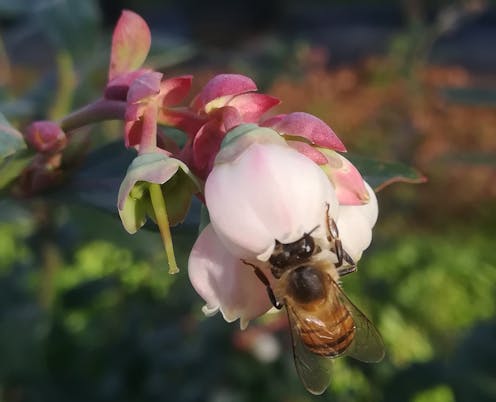
Next time you see a bee hovering around a fruit tree, you’re probably witnessing pollination in action. Pollination is what enables a plant to produce seeds and fruit – and, as research has shown, pollination by insects can greatly improve the quality and quantity of fruit produced.
There’s mounting evidence of a decline in the populations of pollinators all over the world. The consequences for agriculture could be significant. In 2008, some scientists calculated the economic value that insect pollination contributed to world agricultural output. The number they came up with was €153 billion a year – it’s likely to be much higher now.
Some fruit crops require very specific kinds of insect pollination. Take blueberries. Their flowers have specialised anthers (the part of the stamen containing pollen) which release large amounts of pollen only when certain pollinators visit them, such as blueberry bees, bumble bees and mining bees. In a process called buzz pollination, bumble bees vibrate their bodies at a certain frequency when they visit blueberry flowers. This triggers vibrations in the anthers that cause the pollen to burst out. The special shape of blueberry flowers and the number of flowers on a blueberry bush mean there’s no way to mechanically pollinate blueberry plants on a commercial scale.
In recent years, blueberries have become increasingly popular because of their perceived health benefits. They’re now planted all over the world, including areas where their natural pollinators don’t occur – like South Africa, where the blueberry exports to the world have grown from 1,792 tonnes in 2014 to 20,013 tonnes in 2021.
In South Africa there aren’t any native pollinators for the fruit in the country, and the local honey bees aren’t seen as an efficient substitute. Farmers are considering importing large bees, like bumble bees, that aren’t native to the country. (The big bees South Africans may see in their gardens that look like bumble bees are actually carpenter bees.) But that could devastate local environments: bumble bees are strong competitors and often outcompete native pollinators for resources, as has been seen in Argentina.
Until now, little research had focused on how honey bees actually perform as blueberry pollinators in South Africa. It was important to fill this knowledge gap, since the honey bee is the country’s only pollinator that occurs in large enough populations, is easily managed and can be moved around to meet commercial needs.
In two related studies, we put honey bees’ pollination abilities to the test on some of the most common blueberry varieties planted in South Africa. Honey bees were found to be reliable pollinators of blueberries, increasing fruit number, fruit diameter and mass and decreasing fruits’ developmental time. Importing bigger bees like bumble bees is simply not necessary.
Read more: What honeybees in South Africa need from people: better managed forage
But our findings also suggest that honey bees perform best on certain blueberry varieties. This shows it’s important to test the efficacy of honey bees on new blueberry varieties brought into countries where honey bees are the only commercially available pollinators. This information can guide variety choice, ultimately improving crop yield and profit returns.
Honey bees in action
Many people in the commercial fruit industry think honey bees are poor blueberry pollinators. There are a few reasons for this.
First, honey bees are substantially smaller than the natural pollinators of blueberries, and they cannot vibrate their bodies at the frequency needed for efficient pollen release.
Also, honey bees are often reluctant to forage in cold weather. So there may be little pollination during periodic cold spells. They have slower foraging times and deposit less pollen on each visit to a plant than other pollinators like bumble bees.
These concerns are valid, but we show that honey bees are far better pollinators of blueberries than farmers may think. Our research shows that, as new cultivated blueberry varieties become available, buzz pollination may not be as key as it was with earlier varieties.
Improvements and questions
We compared fruit produced through hand-pollination to fruit produced through honey bee pollination.
Read more: Shining fluorescent light on bee sperm could help explain colony survival
Honey bee pollination consistently produced better results than no pollination. We found that, on average, when blueberry plants were not pollinated, they produced 47% less fruit and the fruits were 13% smaller than with honey bee pollination. Blueberries also took 6% longer to ripen without honey bee pollination than with it.
There is room for improvement. Bees were able to fully pollinate some plant varieties, but were not as efficient at pollinating other varieties.
Certain varieties are not reaching their full potential fruit production because not enough high-quality pollen is being transferred between flowers. Our research suggests that this may not be due to the inefficiency of bees. Instead, it comes down to pollen movement between varieties. We also suggest that the way the blueberries are planted makes a difference and will explore this hypothesis in a forthcoming paper.
Next steps
We hope that our findings will debunk the notion that highly invasive pollinators need to be imported into South Africa.
We’re not the only ones testing honey bees’ efficiency as pollinators. The importation of bumble bees is prohibited in India because of the risks they pose to local ecosystems. Researchers there are testing honey bees’ pollination performance in different settings, including greenhouses.
This sort of research can help guide policy makers and farmers to decide how best to boost blueberry yields without putting native pollinators and flora at risk.
This project recieved funding from The National Research Foundation (South Africa), BerriesZA , the Claude Leon Foundation and the Eva Crane Trust.
This article was originally published on The Conversation. Read the original article.







